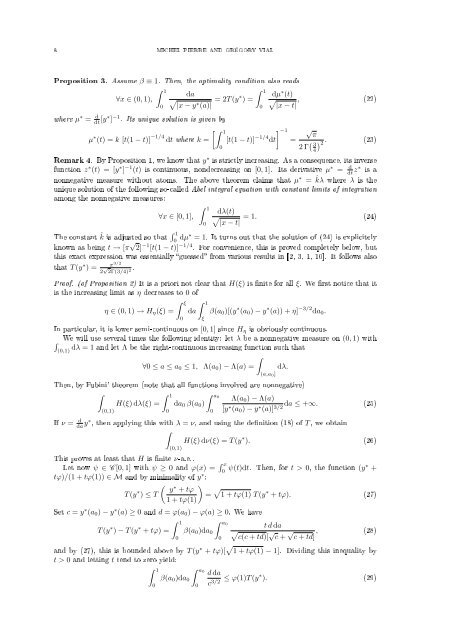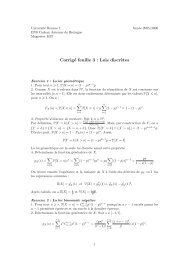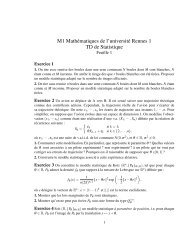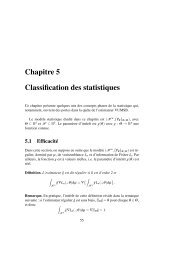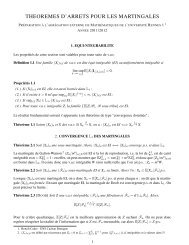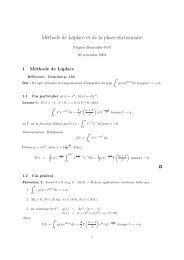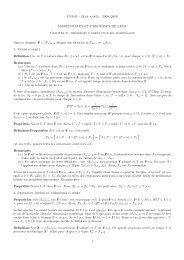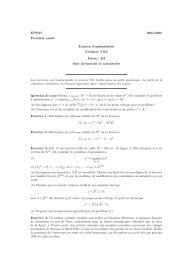best design for a fastest cells selecting process - ENS de Cachan ...
best design for a fastest cells selecting process - ENS de Cachan ...
best design for a fastest cells selecting process - ENS de Cachan ...
- No tags were found...
Create successful ePaper yourself
Turn your PDF publications into a flip-book with our unique Google optimized e-Paper software.
8 MICHEL PIERRE AND GRÉGORY VIALProposition 3. Assume β ≡ 1. Then, the optimality condition also reads∀x ∈ (0, 1),∫ 10da√|x − y∗ (a)| = 2T (y∗ ) =where µ ∗ = d dt [y∗ ] −1 . Its unique solution is given by[∫ 1−1µ ∗ (t) = k [t(1 − t)] −1/4 dt where k = [t(1 − t)] dt] −1/4 =0∫ 10dµ ∗ (t)√|x − t|, (22)√ π2 Γ ( )3 2. (23)4Remark 4. By Proposition 1, we know that y ∗ is strictly increasing. As a consequence, its inversefunction z ∗ (t) = [y ∗ ] −1 (t) is continuous, non<strong>de</strong>creasing on [0, 1]. Its <strong>de</strong>rivative µ ∗ = d dt z∗ is anonnegative measure without atoms. The above theorem claims that µ ∗ = ˆkλ where λ is theunique solution of the following so-called Abel integral equation with constant limits of integrationamong the nonnegative measures:∀x ∈ [0, 1],∫ 10dλ(t)√|x − t|= 1. (24)The constant ˆk is adjusted so that ∫ 10 dµ∗ = 1. It turns out that the solution of (24) is explicitelyknown as being t → [π √ 2] −1 [t(1 − t)] −1/4 . For convenience, this is proved completely below, butthis exact expression was essentially guessed from various results in [2, 3, 1, 10]. It follows alsothat T (y ∗ ) =π 3/22 √ 2Γ(3/4) 2 .Proof. (of Proposition 2) It is a priori not clear that H(ξ) is nite <strong>for</strong> all ξ. We rst notice that itis the increasing limit as η <strong>de</strong>creases to 0 ofη ∈ (0, 1) → H η (ξ) =∫ ξ0da∫ 1ξβ(a 0 )[(y ∗ (a 0 ) − y ∗ (a)) + η] −3/2 da 0 .In particular, it is lower semi-continuous on [0, 1] since H η is obviously continuous.∫ We will use several times the following i<strong>de</strong>ntity: let λ be a nonnegative measure on (0, 1) withdλ = 1 and let Λ be the right-continuous increasing function such that(0,1)∫∀0 ≤ a ≤ a 0 ≤ 1, Λ(a 0 ) − Λ(a) = dλ.Then, by Fubini' theorem (note that all functions involved are nonnegative)∫∫ 1 ∫ a0Λ(a 0 ) − Λ(a)H(ξ) dλ(ξ) = da 0 β(a 0 )da ≤ +∞. (25)[y ∗ (a 0 ) − y ∗ (a)]3/2(0,1)00If ν = d da y∗ , then applying this with λ = ν, and using the <strong>de</strong>nition (18) of T , we obtain∫H(ξ) dν(ξ) = T (y ∗ ). (26)(0,1)This proves at least that H is nite ν-a.e..Let now ψ ∈ C [0, 1] with ψ ≥ 0 and ϕ(x) = ∫ x0 ψ(t)dt. Then, <strong>for</strong> t > 0, the function (y∗ +tϕ)/(1 + tϕ(1)) ∈ M and by minimality of y ∗ :( yT (y ∗ ∗ )+ tϕ) ≤ T= √ 1 + tϕ(1) T (y ∗ + tϕ). (27)1 + tϕ(1)Set c = y ∗ (a 0 ) − y ∗ (a) ≥ 0 and d = ϕ(a 0 ) − ϕ(a) ≥ 0. We haveT (y ∗ ) − T (y ∗ + tϕ) =∫ 10β(a 0 )da 0∫ a00(a,a 0]t d da√c(c + td)[√ c +√c + td], (28)and by (27), this is boun<strong>de</strong>d above by T (y ∗ + tϕ)[ √ 1 + tϕ(1) − 1]. Dividing this inequality byt > 0 and letting t tend to zero yield:∫ 10β(a 0 )da 0∫ a00d dac 3/2 ≤ ϕ(1)T (y∗ ). (29)


